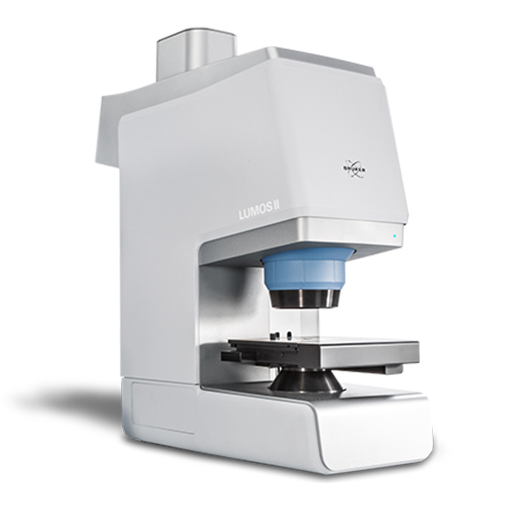
LUMOS II FT-IR Microscope
The LUMOS II is a stand-alone FT-IR microscope that excels in failure analysis, material research and particle analysis. It is compact, precise and features ultrafast chemical imaging by FPA technology.
Exceptional IR.
Brilliant Visuals. Ultrafast Imaging.
The FT-IR Microscopy and Imaging Powerhouse
EASY EFFECTIVE PRECISE
Infrared Microscopy the way it was meant to be.
More space for sample preparation. More speed for chemical imaging. More perfomance in ATR, transmission and reflection microscopy. This is what we call a true game changer – no discussion.
LUMOS II technical features:
- Standard TE-MCT detector
- Plug & Play: no liquid nitrogen, no dry-air purge
- Optional FPA-imaging detector
- Novel PermaSure+ calibration technology
- Fully motorized and automated hardware
- Accomodates samples of up to 40 mm in height
- Long lifetime of components including laser
- Inert to high humidity (ZnSe Optics)
- Stand-alone design, small footprint
- Low power consumption
LUMOS II provides:
- Ease-of-use by software guided measurements
- High-definition spectral and visual data
- High IR sensitivity without liquid nitrogen
- Visual resolution in the sub micrometer range
- Ultrafast FPA imaging performance
- FPA imaging ATR/transmission/reflection
- Easy access to the sample stage
- Compliance to cGMP and FDA 21 CFR p11
- Automated OQ/PQ/pharmacopeia tests
- Anytime upgradeability
Applications
- Failure analysis
- Particle & surface analysis
- Industrial manufacturing
- Forensic science
- Life science
- Polymers & plastics
- Environmental science
- Pharmaceuticals
The Anywhere / Anyone FTIR Microscope

We believe that it is high time to make advanced techniques available to every user, regardless of their skill level. The benefits of FT-IR imaging and microscopy are too great to restrict access by cumbersome hard- and software.
From the start the LUMOS II was meant to make FT-IR imaging faster, easier, more accurate and reliable – and even more fun. Of course, this required us to include new and improve upon proven technology.
That’s why we tailored the LUMOS II, its software and user interface specifically to the user. Beginners get perfect results in no time, while experts maintain total instrument control.
Superior µ-ATR FT-IR Capabilities
It comes down to this: Better instrument. Better results.
Whether it is transmission, reflection or attenuated total reflectance (ATR), the LUMOS II is always the right choice. But its greatest strength is ATR microscopy enhanced by FPA technology. This makes the LUMOS II a universal tool for failure analysis and product development.
To cut a long story short, its ATR capabilities are unsurpassed. Period. Don‘t settle for unreliable, manual ATR accessories – get the best. Get the LUMOS.
The retractable crystal is controlled by high precision piezoelectrical motors and integrated into the lens. This allows you to enjoy a clear view of the sample while your measurement still takes place exactly where you want it.
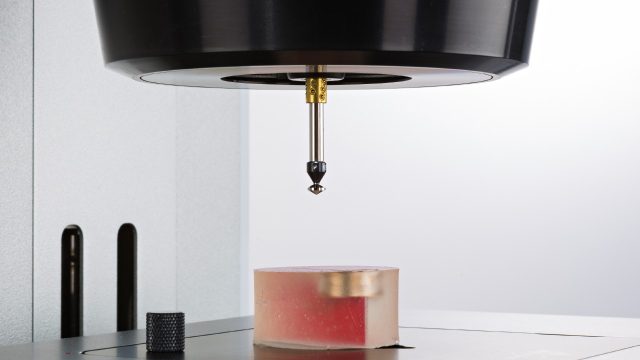
Innovation in FT-IR Microscopy in Every Fiber
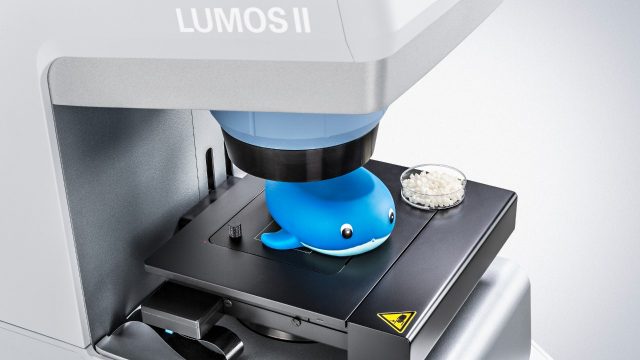
Endurance and power for your applications.
For us it is a natural thing to pass on the best technology to our customers. Of course, this also applies to the LUMOS II.
The RockSolidTM interferometer guarantees constant performance, while modern electronics ensure mechanical precision and low energy consumption. Meanwhile, the software monitors instrument effectiveness and always ensures correct functionality.
Choose your µ-FT-IR Application
Particle and Surface Analysis
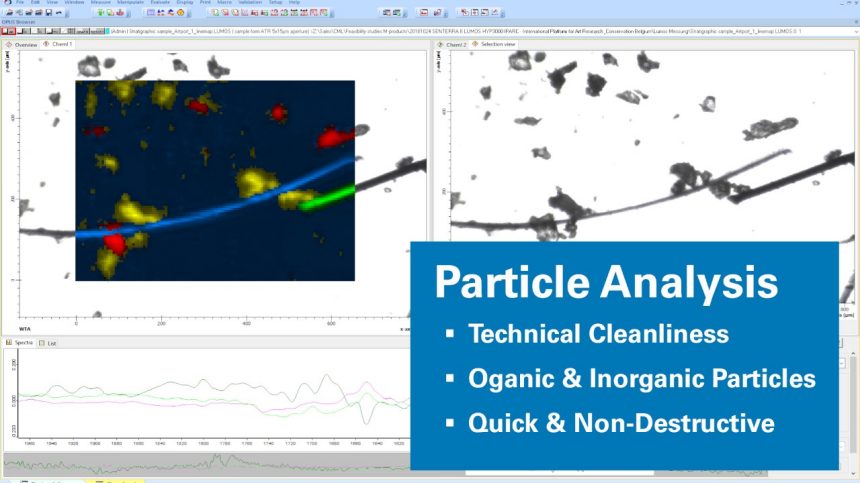
Whether it be technical cleanliness, the investigation of particles or the verification of coating homogeneity. With special software features to identify particles and measure them automatically, the LUMOS is your steady partner for the analysis of any particle on any surface.
Industrial Manufacturing
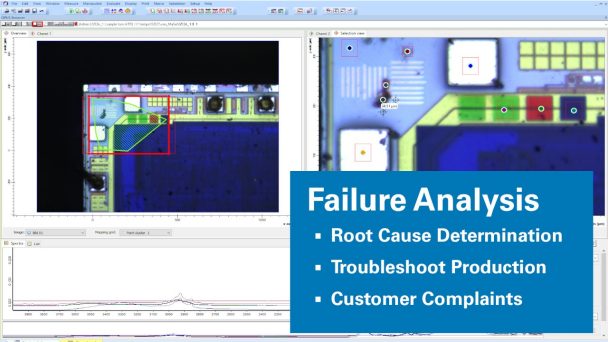
All kinds of organic and inorganic substances are used in industrial manufacturing. and thus, damages and defects can take many different forms. As a truly universal technique, FT-IR microscopy is of great help in these failure and root cause analysis applications.
Environmental Sciences
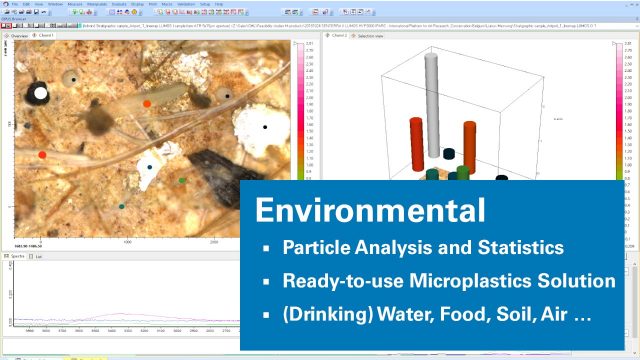
Chemical and particle contaminations strongly influence our ecosystem. Use FT-IR microscopy and imaging to assess pollution in soils, water and air. Investigate complex samples like sediments, geological samples and determine residual matter on filters.
Life Science
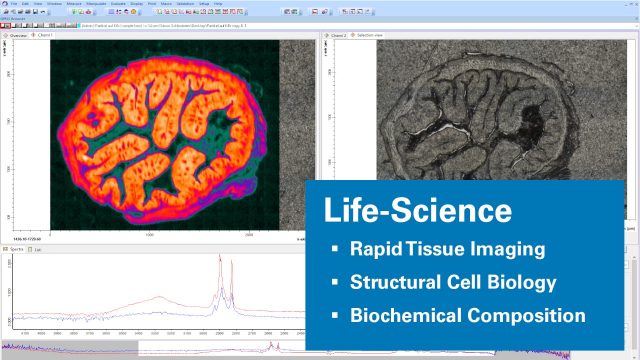
Analysis with micro-FT-IR provides important insights into biology. It enables the discovery of specific disease patterns, dysfunctional tissue or even new disease related biomarkers. With fast imaging capabilities and a huge field of view the LUMOS II simplifies lengthy tissue investigations.
Forensics
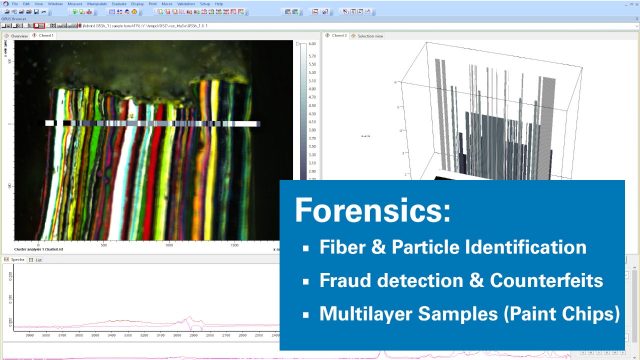
The tiniest detail may be of paramount importance when it comes to forensics. FT-IR microscopy is the method of choice to investigate smallest trace evidence. Analyze fibers, drugs, paints and varnishes and get to the bottom of complex analytical questions.
Polymers and Plastics
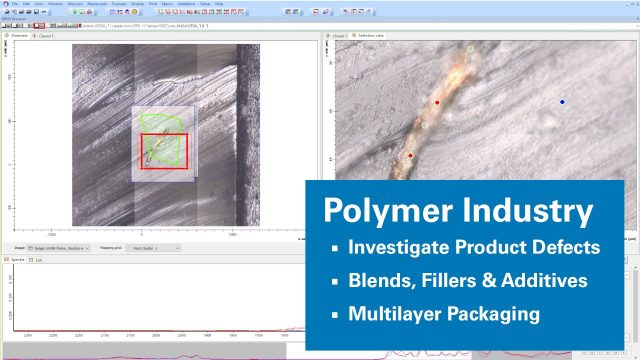
FT-IR is one of the most important analytical techniques in polymer science. It is precisely in this area that infrared microscopy provides access to unparalleled levels of detail. Use it to track the causes of product defects, such as inclusions impurities and inhomogeneities. Start uncovering the chemical composition of complex materials, multilayer structures, laminates, composite materials and varnishes.
Art and Restoration
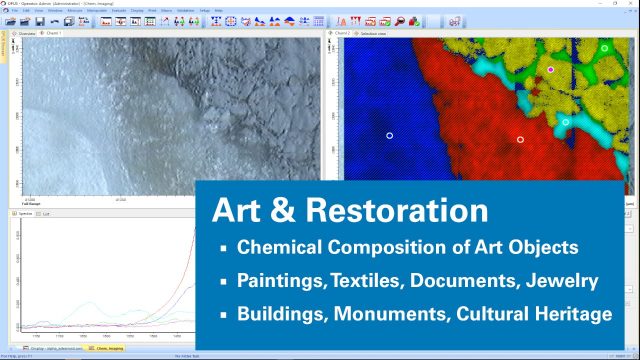
The LUMOS II helps to discover the composition of colors used in historical paintings and takes a closer look at the chemical degradation of marble in antique statues. Its stand-alone compact form factor allows travel, easy setup and precise results.
Pharmaceuticals
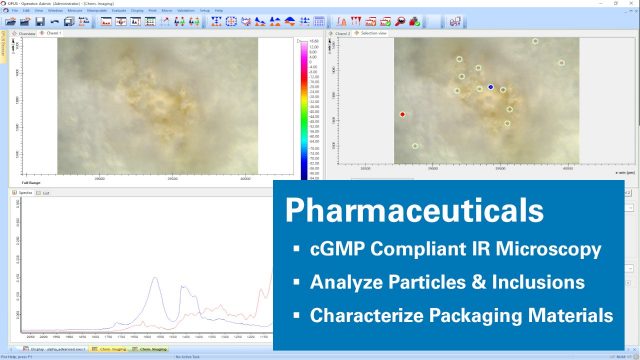
The LUMOS II is fully compliant to all pharmaceutical regulations such as cGMP, GLP FDA 21 CFR part 11 and all pharmacopeias. Automated instrument qualification tests (OQ/PQ/PhEur/PhJp/USP, further) give you time to focus on your analytical tasks: examine tablets, granules and powders, detect and identify particles and other contaminations; determine API and excipient distribution.
Surface Science
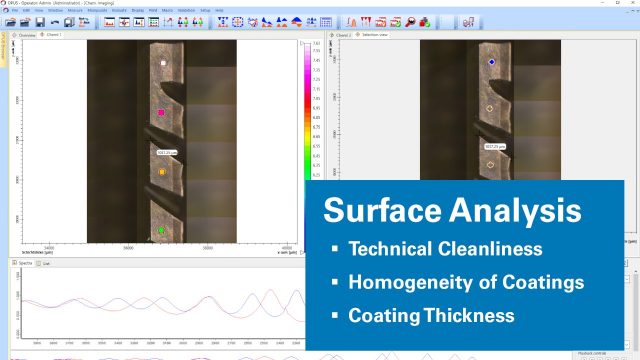
Evaluate surface treatments, coatings or cleanliness by using FTIR microscopy. Organic and inorganic films on finished products are investigated for their uniformity and the layer thickness.
LUMOS II Application Videos
Coating defect analysis by ATR-FT-IR microscopy.
Particle root cause analysis performed by IR microscopy.
PCB failure analysis by FT-IR microscopy.
Multi-layer film and laminate analysis by macro ATR imaging.
Adhesive layer analysis o a food packaging film by FT-IR microscopy
Coating thickness analysis of DLC layers by FT-IR microscopy.
Anti-corrosive coating analysis on a metal surface by FPA imaging.
Composite multi-layer polymers analyzed by ATR-FT-IR.
Textile and fleece quality control by FT-IR microscopy.
Diamond gemstone analysis by FT-IR microscopy.
See for yourself how well IR and VIS data match with LUMOS II.
Testimonial: Microplastics
The team led by Dr. Martin Löder and Prof. Christian Laforsch maintains one of the leading microplastics analysis laboratories in Germany.
OPUS Release 8.8 | LUMOS II | Q3 2023
New Feature: 3D FocusFusion now allows the creation of visual images of infinite “sharpness”
This new feature creates a pin sharp visual image, even if the sample has a rough surface or isn’t flat at all.
This infinite “sharpness” in microscopic images helps in region of interest selection. Now it will be possible to generate sharp visual images of samples for which the depth of field of the LUMOS II is limited.
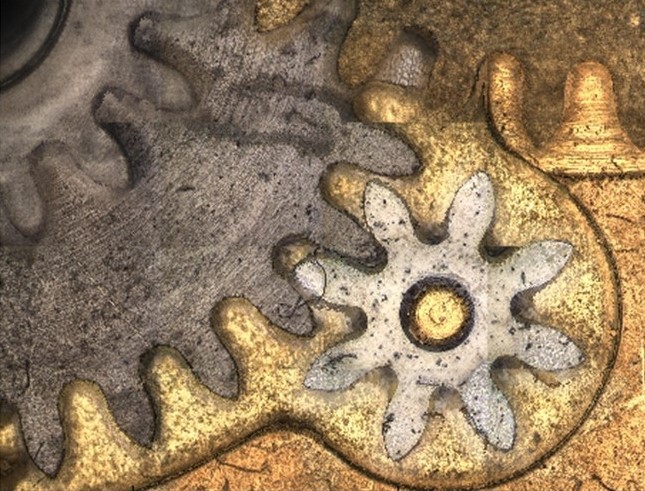
New Feature: FPA imaging can now follow round / circular measurement areas
Now, the measurement grid can be placed in a round shaped way to measure a whole particle filter with FPA imaging. By only measuring the actual region of interest users safe significant amounts of time during FPA measurements of round regions of interest like filters in microplastic analysis.
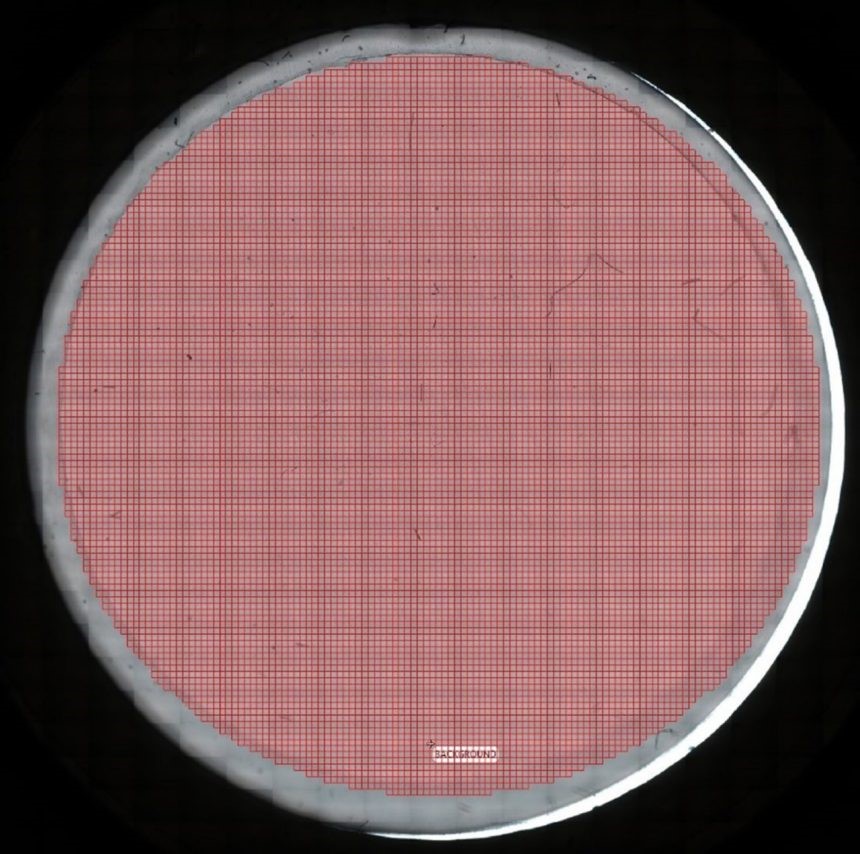
OPUS Release 8.7 | LUMOS II | Q3 2021
New Feature: High Performance Chemical Image Generation by New Adaptive K-means Clustering Function
This new function is the logical next development step for our well known Cluster analysis function.The Adaptive K-means Clustering Function is based on a new algorithm, which enables a non-supervised and autonomous determination of spectral variance within your imaging or mapping results.
- Forecasting or time consuming searching of the included amount of chemical classes is no longer been necessary as the algorithm can predict all included chemical classes by itself.
- This major function is important for all kinds of chemical imaging and distribution analysis of unknown samples or small structures within larger datasets.
- Together with the LUMOS II analysis and evaluation is as easy as possible and safes your valuable time and nerves.
New Feature: “Cluster ID” Function for Identification of Classes in 3D Spectral Data
Our new Cluster ID function enables the identification of clusters within imaging and mapping data using the OPUS functions: spectrum search in libraries, quick compare, or identity test.
- Easy determination of the chemical identity of classified sample components for particles, layers in laminates, components of pharmaceutical tablets and other inhomogeneous materials.
- Reliable and comprehensive statistics reports about quantity, size and of course identity of all analyzed structures is provided and leads particle and technical cleanliness analysis to a new, autonomous level.
Updated Feature: “Find Particles” function now contains a novel particle detection method
The proven “Find Particle” software can now be applied to both: the visual and the IR image. With this updated feature, you are able to do particle detection based on chemical images that were measured by the LUMOS II.
- While particle recognition for low contrast structures and off-white/transparent particles/fibers on off-white filter membranes can be tedious, a postrun particle determination based on the chemical IR image allows you to determine quantity and size of particles from your imaging or mapping results.
- With the Find Particle Function together with the LUMOS II you will never miss any detail – neither in visual nor in IR range.
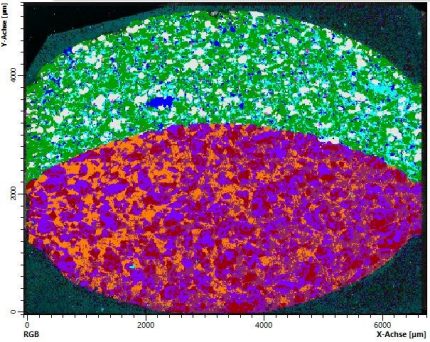
Fully automatically created chemical images by the new adaptive k-means clustering function.
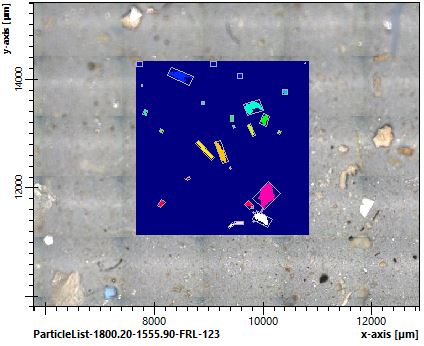
Automatically recognized particles on an aluminum oxide filter. Particles are immediately classified by size and identity with the new “Cluster ID”.
